
When we moved into our home nearly four years ago, we committed to planting and maintaining an edible landscape. We currently only have enough space to grow things that we can eat; therefore, everything that grows in our tiny little yard has purpose and nutritional value. Thankfully this means we can grow beautiful flowers that are visually appealing, packed full of vitamins, and super yummy!
Like growing calendula, nasturtiums (Tropaeolum majus) are perfect for those who really want to grow their own, but have a limited amount of time, gardening experience, patience, space, or money. No matter what shade of green your thumb may be, I am almost positive that you can successfully grow nasturtiums!
Here are a few reason why everyone should grow these lovely edible flowers:
1. They’ll grow almost anywhere. Nasturtiums are a great plant if you’re looking to fill in bare areas because they are so quick to germinate and oh so hardy. Toss a packet of seeds into the soil, water, and within a matter of weeks you’ll have injected your landscape with a kaleidoscope of vibrant color. Is your outdoor space limited? No worries, plant your seeds in window boxes, raised beds, or pots. Nasturtiums thrive in poor soil and grow well in full-sun or partial shade. They will attempt to re-seed themselves however they are considered an annual.
2. Nasturtiums are very affordable and super easy to grow. They grow the best from seed so there’s no need to purchase expensive transplants from a nursery. I have purchased seeds locally, and I have a couple packets from Johnny’s Seeds and Horizon Herbs that really produce lovely plants. Nasturtium seeds are fairly big and look like peas, they seriously are some of the easiest most forgiving plants in the garden…great for beginners!
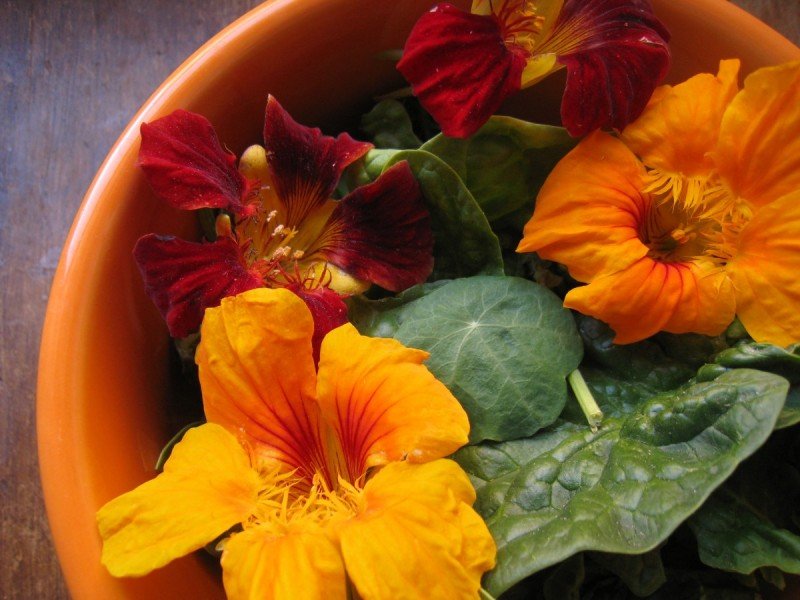
3. They are edible. In fact, the entire plant is edible…leaves, flowers, stems, seeds, and all. I consider nasturtiums a spicy green, and grow them in my garden as such. Add the leaves and flowers to any green salad, stuff the blossoms with an herb cream cheese, or chop them and add to pastas for a delicious addition to any meal. During the mid 20th century, people used nasturtium seed pods as a replacement for pepper. We can still do this today! All you have to do is wait for the seeds to dry and then grind them in a coffee grinder (I have one that I use specifically for herbs). Note: Make a yummy herbal seasoning salt by adding ground nasturtium seeds with other dried kitchen herbs from the garden.
4. They’re not picky, and they’ll grow well in any type of soil. The trick with nasturtiums is not necessarily the quality of soil they are planted in, just be sure to keep them well watered throughout the growing season…especially if you’re growing them in containers. In all honesty, there’s no need to put to much effort into the soil. Because, if its’ too rich you’ll end up with more leaves than flowers. Nasturtiums simply do better in poor soil! Bonus!

5. They are a great companion plant. Nasturtiums help deter aphids, squash bugs, white flies, cucumber beetles and a host of other pests. Plant them along side veggies such as tomatoes, cabbage, radishes, and cucumbers. Note: They really attract aphids; so, if you start to notice a real problem whip up a batch of this homemade pesticide, but avoid chemical sprays especially if you will be eating the foliage.
6. Nasturtiums are nutritionally dense, as their leaves contain significant levels of vitamin C and iron. Medicinally they are known to be useful in breaking up congestion of the respiratory system and they provide excellent relief from colds. Likewise, nasturtium is said to encourage the formation of blood cells and can be given as a blood purifier and detoxifier. When preparing for a harvest, remember to choose fresh leaves and flowers that show no sign of browning or withering.
Are nasturtiums a staple in your garden? What other edible flowers do you grow?

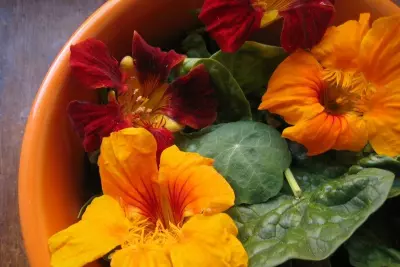
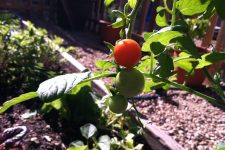
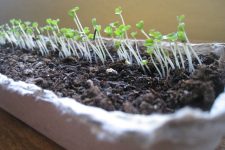
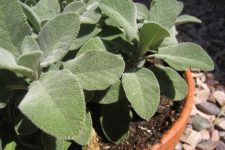
 Meal Planning and Keeping a Stocked Pantry
Meal Planning and Keeping a Stocked Pantry
I’d never heard of these until just last week and we decided to start growing them this year. I had no idea they were so useful and healthy! Thanks for the info – cant wait to try them!
Oh yes! They are super nutritious and very tasty. I hope you have a great harvest of blossoms 🙂
this is such valuable information. My hubby and I were just talking about only growing things we could consume along with plants that have a medicinal purpose to it. Thanks for sharing.
It’s what I love Lori…so you’re very welcome. Good luck to you and your husband this growing season!
Beautiful blog, great article! Just wanted to let you know another great nasturtium recipe – nasturtium seeps capers! The recipe is in Sandor Katz’s book Wild Fermentation. The seeds can be lacto-fermented into a wonderful variation on the well known caper berry. Easy, delicious, good for your digestion!
Yes Sheila! That is another excellent way to prepare the seeds…super yummy!
I love these flowers….but I had no idea you could eat them! 🙂 I have this hard time picking pretty flowers though…I so enjoy them while they’re beautiful in the ground.
Oh wait…I mean, I enjoy the NEIGHBORS’ flowers while they’re in the ground. I don’t grow flowers. Do you think they’d notice if I went over in the night and picked them incognito?
Oh Stacy!!! We’ll turn that black thumb of yours green before you know it 🙂
I grow nasturiums too ! Because space is limited in my yard I grow them in window boxes – they grow quickly and have continuous blossoms. I use them in salads and have made hummus too – check my post for the recipe. http://simplehomecraft.blogspot.com/2011/10/simple-nasturtium.html
Thank you so much for sharing Janet! What a yummy recipe!
I guess I’m not very adventurous, but I just can’t bring myself to even trying an edible flower. At least, I haven’t eaten one as far as I know. Once of these days I may be able to, but right now, no.
They are so yummy Ila 🙂 But I totally understand where you are coming from!
I have some seeds for this flower I’ll be planting soon. BTW, thank you for the link of local harvest. I was able to find several local farms that have CSA. I’ll be trying them out along with this Nasturtium recipe.
That’s so awesome Sandi!
I love nasturtiums and plan on planting a ton up here in Milwaukee. I have a question though…in your #5 you said “Nasturtiums help deter aphids…” but in the same paragraph yous say “Note: They really attract aphids…”
Could you clarify that? Aphids aren’t a problem so far for me, but I’d like to be prepared.
Yes Jill! That is confusing wording 🙂 Nasturtiums help to deter aphids away from other plants by attracting them. They are often planted as a companion plant for that purpose.
Nasturtiums are a must have in my garden and this year I even get to add the climbing ones (hadn’t been able to find them locally until last fall) They’re fun to feed to unsuspecting victims too 😉
LOVE it!
I LOVE Nasturtiums. They are one of the few flowers that grow well in the Pacific Northwest. I try to grow them every year. Last year I got one climbing seed in with my bush varieties. It grew up and over the fence and into the neighbors yard. They enjoyed and and thought it was so funny to see how well it did. 🙂
We love them on tuna fish sandwiches. Adds a nice spicy punch.
I’ll have to try stuffing the flowers with cream cheese. Would be a pretty appetizer to serve with crackers.
I’ll also have to try grinding the seeds.
Wow! I really need to add them to our tuna fish sandwiches! That sounds awesome!
I used to grow nasturtiums as a child. I need to plant them again this year. I’m really itching for the growing season to start here. I’m giving away a packet of my family’s heirloom green bean seed on my blog this week to celebrate April and the hope of being able to plant soon.
Share a link with us Melissa so we can all join in 🙂
Thanks, Andrea! Here’s the link for the heirloom seed giveaway http://melissaknorris.wordpress.com/2012/04/01/pioneering-today-heirloom-tarheel-green-bean-and-seed-giveaway/
Awesome! Thank you for sharing!
I planted these by my zucchinis last year, but didn’t find that they helped deter squash bugs :/ I didn’t know the nutritional value of them, though! I have some seeds left, so maybe I will plant them again 🙂 they. Are beautiful!
Has anyone had a problem with slugs attacking the plants?
Hey, Andrea! I just planted nasturtiums a couple of days ago after I read your article. I hope I did it right. The package said to file the seed to allow it to germinate. I am going to photograph their progress as they grow. I can’t wait to add those blooms to salads! Thanks for inspiring me to plant something. I had a blast digging in the dirt. My daughter and I had a good laugh about using the plastic toys from the sandbox as our gardening tools!
I LOVE it Rachel! That’s awesome!
Hello! Thanks for posting this article. Most informative & interesting! We grew up with nasturtiums, but only now very recently (aged 40) started delving into herbs & edible/medicinal plants. Nasturtiums grow … well … like weeds in our garden. Tonight we made “nasturtium flapjacks” & served it with homemade cottage cheese. I’m looking for more recipes though, using the stems & roots as well. Our “edible garden” is so exciting! (From South Africa)
Just curious- I’m thinking of planting nasturtiums among my strawberries. Should I plant them a few feet away instead since nasturtiums attract aphids?
Love Nasturtium! Like watercress, tasty and nutritious. TIP on aphids and bad bugs- easy solution- plant a few marigolds (flowers) around any edible plant, tomatoes, whatever. Chrysanthemum flowers work great also, as they make natural Pyrethrum. These flowers seem to kill or deter bad bugs, but do not hurt good bugs, and are not harmful to humans. Try it- better than pesticides!
THis was the first plant I have grown ever this year is my first flower garden. THe plant has continued to grow and grow like a beautiful bright orange vine along my flower bed and I am telling you now every morning I leave to go to work I see it and it makes my day so much better for a start! Just a pack of seeds and up it came! Its beautiful! Love your helpful info! I cant believe these are edible! WOW!
I’m having issues with the retina in one eye and my doctor told me clinical trials indicated that lutein could help. I looked up food sources for lutein and found nasturtium to be the most lutein rich food plant, followed by kale. It just so happens I grow nasturtium for organic pest control and since I’m not having a pest problem this year, my nasturtium plants are growing like crazy, and I’m eating them like crazy on my green salads!
I live in the country and planted nasturtium seeds on both sides of my gate last year and I had a beautiful crop all summer. Now they have only started to come out on one side of my gate this year. Have you any idea why or do you think there is still time yet.
I’m new to all of this. I’m not a gardener, but I’m very interested in this plant. I live in an apartment & am very limited on space. What is the best way to get started? Are there any contra-indications to medicine?
Thanks for your help.